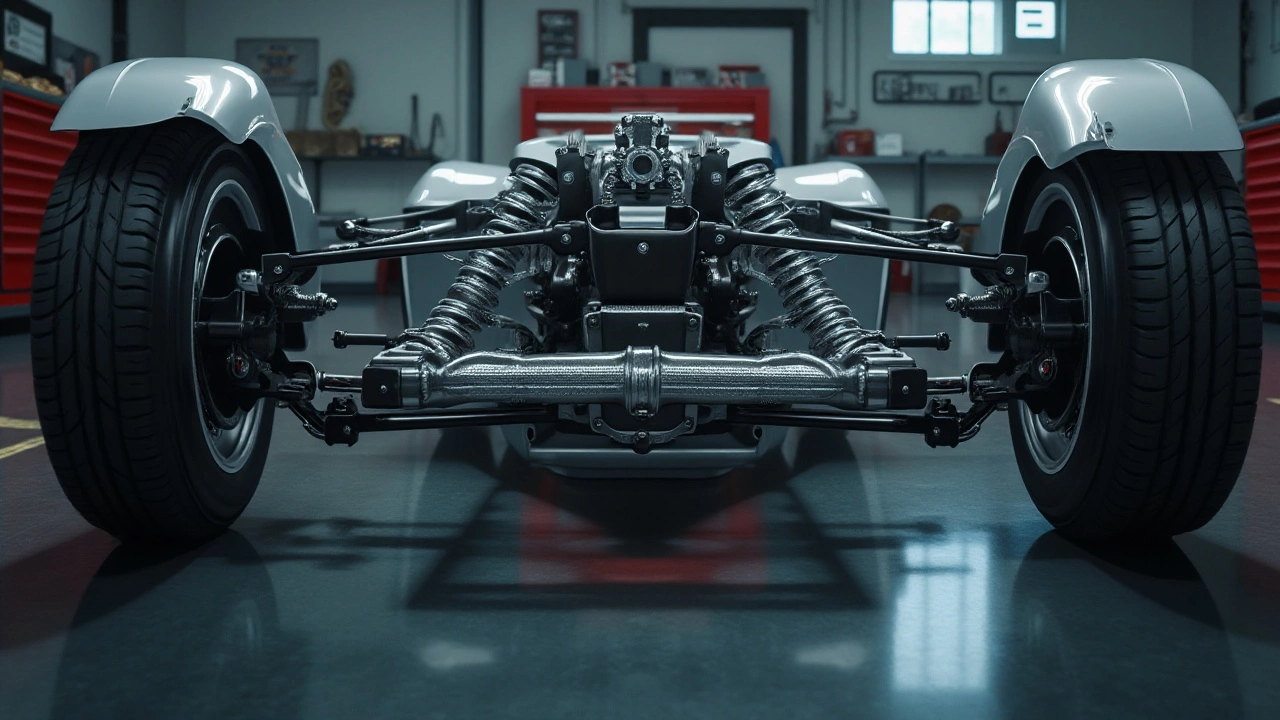Suspension Parts: Keep Your Ride Smooth and Safe
When working with Suspension Parts, the components that connect your wheels to the vehicle chassis and control motion. Also known as suspension components, they absorb bumps, keep tires in contact with the road, and ensure handling stability. Key elements include Shock Absorbers, devices that dampen vertical movement, Springs, coils or leaf packs that support vehicle weight, and Bushings, rubber or polyurethane inserts that reduce metal‑to‑metal friction. Knowing how these parts interact helps you spot problems early and avoid costly repairs.
Common Signs Your Suspension Parts Need Attention
Most drivers notice a change before a part actually fails. A squeaking or clunking noise when you go over a pothole usually points to worn bushings or loose mounting bolts. If the car leans excessively during cornering, the springs may be sagging or the shock absorbers are losing damping force. Uneven tyre wear—especially feather‑edge wear on the inner or outer shoulders—often signals a mis‑aligned suspension or a broken strut mount. These clues form a simple rule: suspension parts affect ride comfort, tyre lifespan, and road handling, so any abnormal symptom deserves a quick inspection.
Doing a basic check yourself can save a trip to the garage. Push down on the front corner of the vehicle; it should rebound smoothly without bouncing. A prolonged bounce means the shock absorber isn’t controlling the spring’s energy. Grab a tyre and wiggle it side‑to‑side; excessive play hints at worn control arm bushings. Remember, the suspension is a system of parts working together, so one weak link can compromise the whole setup.
When you decide a part needs replacement, it’s useful to understand the typical lifespan. Front shock absorbers on a UK‑based daily driver usually last between 70‑100 000 miles, while springs can survive the entire life of the car if they’re not overloaded. Bushings, on the other hand, are prone to early wear in harsh climates or if you frequently drive on rough roads. Knowing these benchmarks helps you plan budget‑friendly maintenance and avoid surprise breakdowns.
Choosing the right replacement part is more than picking the cheapest option. OEM‑branded shock absorbers often match the vehicle’s original ride characteristics, whereas performance‑oriented units can stiffen the ride for better handling but may sacrifice comfort. For springs, consider whether you need standard height, lowered, or lifted variants based on your driving style. Bushings come in rubber, polyurethane, or solid metal; polyurethane offers durability but can transmit more road noise. Selecting the appropriate type ensures the new component integrates smoothly with the rest of the suspension system.
Installation tools vary by part. Replacing a shock absorber typically requires a socket set, spring compressors, and a torque wrench to hit manufacturer specifications. Spring replacement is more involved; you’ll need a spring compressor and safety braces to avoid sudden release of stored energy. Bushings often need a press or a set of pick‑type tools to extract the old part without damaging surrounding brackets. If you’re not comfortable with these tools, it’s wise to let a qualified mechanic handle the job.
With these basics in mind, you’re ready to dive into the deeper details. Below you’ll find articles that break down each component, show you how to diagnose specific symptoms, and guide you through cost‑effective repairs. Whether you’re a DIY enthusiast or just want to know what the garage is talking about, the collection will give you the knowledge to keep your suspension performing at its best.

Front Suspension: How Do I Know When It's Time for a Change?
May 28 2025 / Suspension PartsWondering if your car's front suspension is shot? This article breaks down the real-life warning signs and weird symptoms to look for—like knocking noises, uneven tire wear, or a ride that feels bumpier than it used to. Learn what these clues actually mean for your car's safety and how they impact your wallet over time. You'll get honest tips for checking your suspension at home, plus advice on when to call a mechanic. Save time, cash, and guesswork with practical know-how.
VIEW MORE
How to Tell if Suspension Is Bent: Spot Trouble Before It Gets Worse
May 4 2025 / Suspension PartsThink your suspension might be bent? This article walks you through the signs to watch for, the parts most often affected, and how minor problems can lead to costly repairs if ignored. You'll get real tips on checking your own vehicle and advice on when it’s time to call in a pro. Don’t second-guess — learn exactly what to look for when you suspect something’s off about your ride. Perfect for everyday drivers who want to keep their car safe and handling right.
VIEW MORE
Fixing a Bad Suspension: Is It Possible?
Mar 30 2025 / Suspension PartsSuspension issues can turn driving into an uncomfortable experience, but the good news is that repair is often possible. This article explores whether a bad suspension can be fixed, diving into common problems, how they affect your ride, and what can be done about them. It offers practical tips for diagnosing suspension issues and insights into repair options. Learn about maintaining your car’s suspension system for a smoother and safer drive.
VIEW MORE
Choosing the Best Front Suspension: A Comprehensive Guide
Feb 2 2025 / AutomotiveDiscover the best front suspension options for your car with this comprehensive guide. Learn about the different types of front suspensions, their benefits, and how they affect vehicle performance. Get helpful tips for choosing the right suspension for your driving needs. Stay informed about recent advancements and industry insights that could influence your decision. Enhance your understanding of what makes a great front suspension system.
VIEW MORE